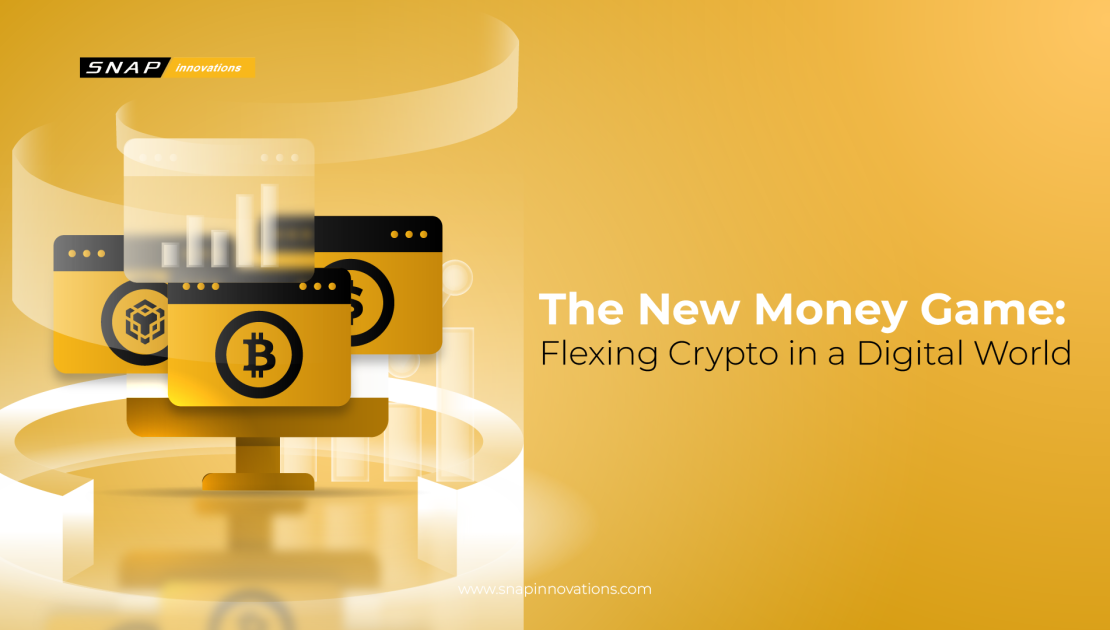The New Money Game: Flexing Crypto in a Digital World

In recent years, the world of finance has witnessed a profound shift. The emergence of cryptocurrencies and blockchain-based technologies has opened up new possibilities for how money is stored, transferred, invested, and displayed. “Flexing money in crypto” showing off large or flashy holdings or gains in crypto assets has become a phenomenon not just of wealth but of culture. At the same time, the underlying technologies and infrastructure suggest that crypto could play a much bigger role in the future of money than just an investment vehicle.
This article explores what “future flexing money in crypto” could mean: the intersection of personal finance, display of wealth, financial technology innovation, and the evolution of money itself. We’ll cover what crypto is, why people might engage in flexing, how the mechanisms work, the comparisons involved, and what the future could hold. The aim is to give a well-rounded understanding but remember: cryptocurrency remains volatile and risky, so this is for education, not financial advice.
What is Future Flexing Money in Crypto
 When we talk about “flexing money in crypto,” we mean two intertwined things. First, there is the personal/psychological/social act of showing off wealth or success via crypto holdings or transactions. Second, there is the larger idea of using cryptocurrency as a form of money, store of value, or means of transaction thereby flexing not just wealth but embracing a future-oriented financial identity.
When we talk about “flexing money in crypto,” we mean two intertwined things. First, there is the personal/psychological/social act of showing off wealth or success via crypto holdings or transactions. Second, there is the larger idea of using cryptocurrency as a form of money, store of value, or means of transaction thereby flexing not just wealth but embracing a future-oriented financial identity.
From the crypto side: cryptocurrencies are digital assets built typically on blockchain technology, enabling peer-to-peer transactions, decentralized systems, and new financial infrastructure. These assets have been framed as “digital gold,” stores of value, mediums of exchange, or speculative vehicles. On the other side, “flexing” means publicly displaying wealth via purchases, portfolios, screenshots, and lifestyle often to gain social recognition. When you combine the two, you have a phenomenon of people using crypto both as a financial asset and a social signal: the “I made this in crypto” brag.
In the future-money sense, flexing also ties into the idea that crypto might become more integrated into everyday finance: payments, savings, global transfers, and so on. If one holds substantial crypto wealth or uses crypto for major purchases, that becomes a kind of flex: “I’m living in the next era of money.” The question is, will this become mainstream and therefore shift from flexing to normality?
Why People Flex with Crypto
 There are several interlocking reasons why people might flex with crypto, and many of them go beyond simply showing off wealth. Crypto flexing often involves social psychology, technology, investment culture, generational attitudes, and even rebellion against traditional systems. It merges the act of displaying success with participation in a new and disruptive financial order. Below are deeper insights into why this behavior is gaining traction.
There are several interlocking reasons why people might flex with crypto, and many of them go beyond simply showing off wealth. Crypto flexing often involves social psychology, technology, investment culture, generational attitudes, and even rebellion against traditional systems. It merges the act of displaying success with participation in a new and disruptive financial order. Below are deeper insights into why this behavior is gaining traction.
1. Social recognition and status.
Flexing is often about gaining attention, respect, or validating one’s success. In the context of crypto, when someone experiences large gains, they may feel the urge to display them—whether via luxury goods bought with crypto profits, portfolio screenshots, or bragging about “getting in early.” Crypto lends itself well to this: rapid gains, volatility, “moonshots,” and stories of 100x returns all create compelling narratives that attract attention. In online communities, especially Twitter (or “Crypto Twitter”), Reddit, and Discord, status is often measured not just by knowledge but by proof of success. This has led to a culture where flaunting crypto wealth is not only tolerated but celebrated.
Moreover, since crypto success is often self-made, many see it as more admirable than inherited wealth. The idea of being a “self-made crypto millionaire” has social capital attached to it. Unlike traditional wealth, which may be hidden or modestly displayed, crypto offers transparency, often through blockchain explorers that show wallet balances or transaction histories, further facilitating public recognition.
2. Identity & belonging.
Crypto communities often have a strong cultural identity: early adopters, rebels against the banking system, decentralized finance (“DeFi”) pioneers, etc. Displaying crypto wealth can thus signal membership in that identity group: “I’m part of the future of money” rather than “just a regular saver.” This adds a layer of social currency beyond financial value. The act of flexing can serve as a badge of loyalty to certain ideologies: decentralization, individual sovereignty, and financial privacy.
Many people new to investing, especially young adults or those from underrepresented economic groups, find a sense of empowerment in crypto. For them, buying into crypto isn’t just an investment; it’s a statement. Participating in meme coins, NFTs, or DeFi isn’t only about making money; it’s about joining a movement. Flexing in this context shows you are not only an investor but also part of something larger than yourself.
Also read: What is Polymarket? A Beginner’s Guide to Crypto Betting and Forecasting
3. Financial independence and disruption.
Some may flex crypto wealth as a way of signalling that they’ve achieved financial independence or that they’re playing a different game than traditional finance. Crypto offers new avenues: high risk, high reward, global accessibility, censorship resistance (ideally), and minimal intermediaries. The act of flexing then becomes both personal and ideological: I don’t follow the old rules of finance; I’m in the new era.
This kind of flex isn’t limited to luxury cars or watches. Some might showcase that they live on crypto full-time, pay their rent or buy groceries using stablecoins, or work for a DAO (Decentralized Autonomous Organization). These aren’t just ways of spending money but ways of rejecting conventional employment or banking systems. The flex, in this case, is a lifestyle and value system, not just a dollar amount.
4. The “FOMO” and discovery narrative.
Many early crypto stories involve individuals who got in early, saw huge gains, and then displayed them. That narrative drives others to want to replicate it part of the “flexing” owes to the storytelling. Because crypto is volatile and has big headlines, the system incentivises showing off wins (often without showing losses). This can create aspirational behavior: “Maybe I’ll make it big too.”
FOMO (Fear of Missing Out) is a powerful motivator in crypto. When someone posts a $1,000 to $100,000 transformation story or flaunts a rare NFT purchase that skyrockets in value, it fuels others to join in. Crypto becomes not just an investment but a game of discovery where being first is everything. Flexing in this environment can serve both as proof of skill and as bait to draw others in.
5. Visibility and technology enabling it.
Blockchain and crypto wallets allow visible proofs (sometimes) of holdings or transactions (though anonymity/pseudonymity plays a role). Social media amplifies everything. The combination of digital infrastructure and creative display means crypto flexing is easier now than traditional wealth display. Screenshots of wallets, NFT galleries, or crypto purchases on-chain are verifiable and shareable. Platforms like Etherscan allow for public inspection of wallet activity, making flexing a part of the protocol.
Technology also makes it easier to gamify status. Wallets can have custom names. NFTs are displayed as profile pictures. Twitter accounts link to ENS domains (Ethereum Name Service), and entire communities build reputations based on digital holdings. You don’t need to wear a Rolex or drive a Lamborghini; you can own a CryptoPunk or Bored Ape and instantly gain credibility in digital circles.
These motivations are rarely isolated. Most people who flex in crypto are driven by a mix of social validation, belonging, ideology, and ambition. The flex is both a signal and a strategy: a way of communicating who you are, what you believe in, and what kind of financial game you’re playing.
Mechanisms & How It Works
 Behind the social display is a set of financial and technological mechanics. To flex in crypto often means having one or more of the following: visible holdings, transactions, gains, high-yield strategies, unique assets (e.g., NFTs), etc.
Behind the social display is a set of financial and technological mechanics. To flex in crypto often means having one or more of the following: visible holdings, transactions, gains, high-yield strategies, unique assets (e.g., NFTs), etc.
Bullet-point list of mechanics
- Large token holdings in wallet addresses. Public blockchains allow wallet addresses to hold visible amounts of crypto.
- High-value purchases from crypto profits. Buying luxury goods (cars, jewelry, property) with crypto gains.
- Unique digital assets (NFTs). Owning rare digital assets can serve as a flex.
- Yield/interest generation. Earning interest or staking rewards can add a flex narrative.
- Use of derivatives/leverage. Showing off trades in futures or leveraged positions as an advanced strategy.
- Transactions & payments in crypto. Spending crypto for goods or services as a show of adoption.
- Social media & screenshot culture. Sharing portfolio snapshots, transaction histories, or luxury purchases.
- Narrative of early adoption. Claiming “I got in early” signals tech savviness and market foresight.
These mechanics combine to produce the phenomenon of flexing. It’s not just about having money; it’s about signalling wealth, status, future orientation, and disruption.
Table Comparison
| Feature | Traditional Wealth-Flexing | Crypto Wealth-Flexing |
|---|---|---|
| Asset type | Real estate, stocks, luxury goods | Digital tokens, NFTs, DeFi |
| Visibility | Physical assets, luxury lifestyle | Digital wallets, screenshots |
| Liquidity & access | Slower, intermediated | Fast, peer-to-peer, 24/7 access |
| Entry barriers | High (capital, regulations) | Lower (global, online access) |
| Volatility | Stable to moderate | High volatility |
| Flex narrative | “I bought a mansion” | “I minted a rare NFT” |
| Technology & identity | Traditional status symbols | Tech-forward, futurist identity |
| Risk & regulation | Well-known, insured | Evolving, uncertain |
| Future money implication | Established systems | Disruptive and growing |
| Social media amplification | Limited to photo posts | Blockchain records, instant proof |
Flexing in traditional finance often relies on physical ownership and lifestyle cues. In contrast, crypto flexing is digital-native and instant, riding on blockchain and social media culture. As crypto matures, it may bridge into the mainstream, reducing the novelty of flexing.
Also read: Top 7 Blockchain Explorers You Should Know in 2025
Conclusion
Crypto has created new ways of flexing wealth that are digital, fast-moving, and highly visible. As blockchain technology advances and more people adopt decentralized finance, the meaning of wealth and the ways we display it may continue to evolve. What is a flex today may be a basic expectation tomorrow.
Still, risks remain. Flexing without understanding the technology or market dynamics can lead to losses or reputation damage. Responsible participation, education, and a long-term view will help people not just flex but thrive in the world of future finance.
I'm Kris, a fintech writer with three years of experience. I've been on a mission to simplify the intricacies of trading through my words, bridging the gap between technology and finance. Join me on this journey as I empower traders and investors with clear, engaging content in the dynamic world of fintech.
